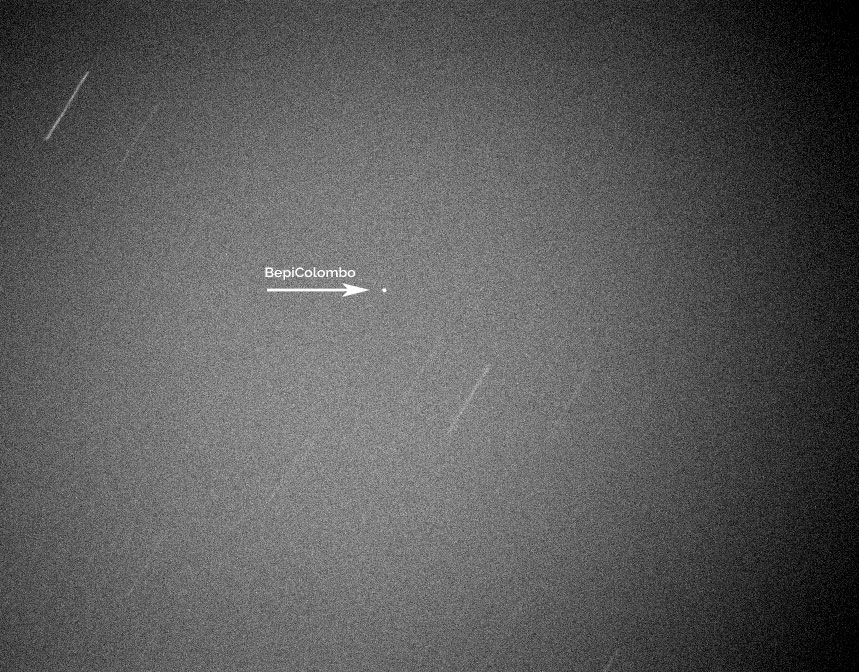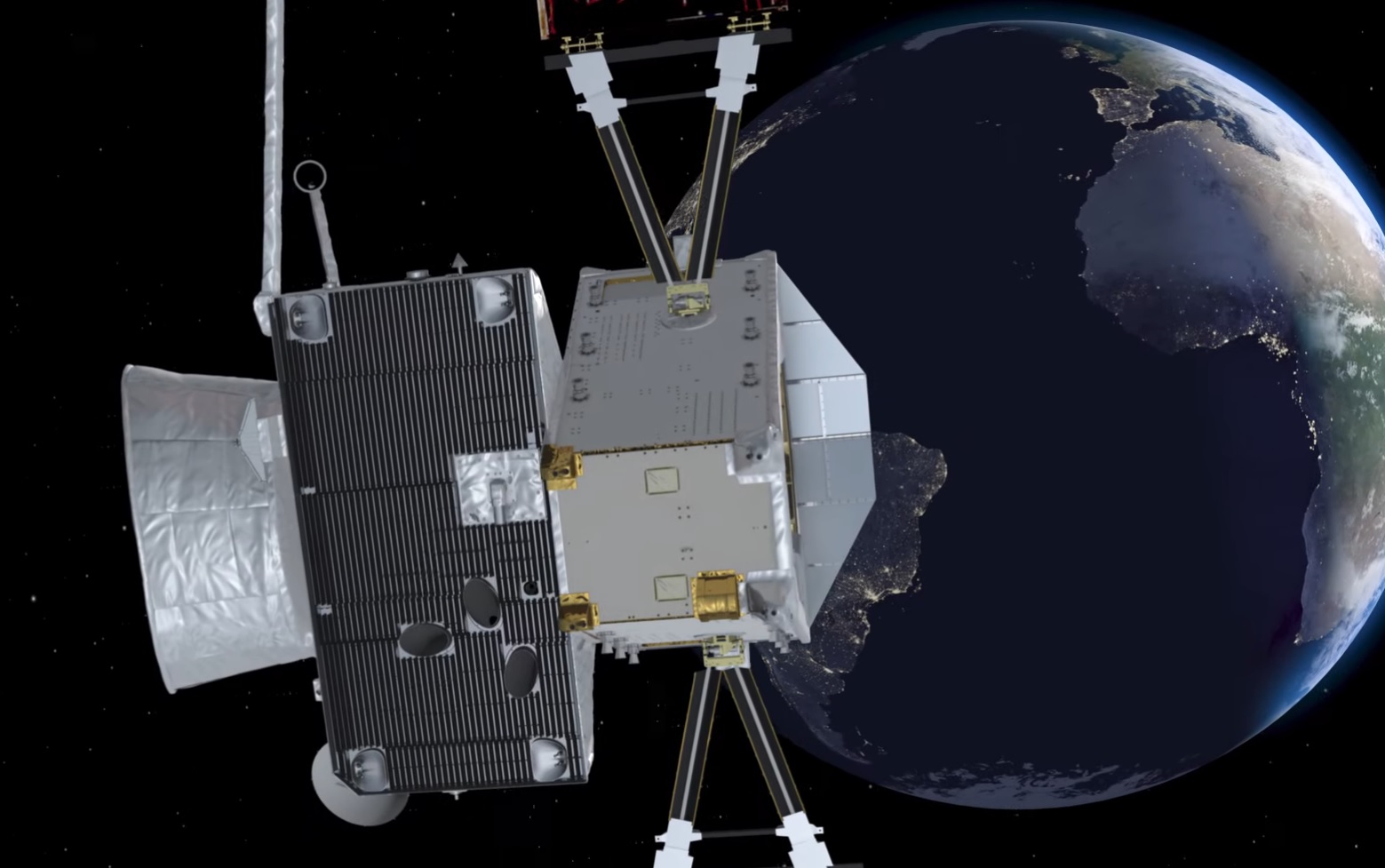BepiColombo, the joint ESA/JAXA mission that’s ultimately bound for Mercury, will swing by Earth on Friday.
Update (April 10, 2020): BepiColombo's flyby past Earth was successful in its first of nine flybys — and the only one past Earth — that will send the spacecraft toward Mercury. Below, we show a picture from the "selfie" camera on board, released by the European Space Agency, as well as the view from Earth, taken by Gianluca Masi using the Virtual Telescope.

ESA / BepiColombo / MTM / CC BY-SA 3.0 IGO

Virtual Telescope
When it comes to solar system exploration, flybys are easy; it’s arriving and staying at a planetary destination that is hard. On Friday, April 10th, the joint Japanese/European BepiColombo mission pays Earth a visit, making its sole flyby past our planet on its long trek towards its final destination: Mercury.

ESA
The Flyby
Closest Earth approach will occur on Friday, April 10th, at 12:22 a.m. EDT (4:22 UT). The spacecraft will fly at 7,900 miles (12,700 kilometers) from the surface of the Earth over the South Atlantic. That’s just over a third of the distance to the ring of satellites in geostationary orbit. The flyby will provide an opportunity to test and calibrate instruments while the sensors and cameras are looking at Earth and the Moon.
Space Operations in the Time of COVID-19
The flyby comes during the COVID-19 pandemic, a time when many space agencies around the world are shuttered or at minimal staffing. The team at the European Space Agency (ESA) will work to guide BepiColombo through the critical phases of Friday’s flyby, all while using physical distancing measures for personnel working at the European Space Operations Centre in Darmstadt, Germany. (Those who can will be working remotely from home.)
“The Earth swing-by is a phase where we need daily contact with the spacecraft,” says Elsa Montagnon (ESA) in a recent press release. “This is something we cannot postpone. The spacecraft will swing by Earth independently in any case.”

ESA / BepiColombo / MTM
Getting to Mercury
BepiColombo will be the second mission to orbit Mercury after NASA’s Messenger mission, which terminated its successful stay by crashing into the innermost planet on April 30, 2015. In addition to this week’s Earth flyby, BepiColombo will make two flybys past Venus, the first of which is later this year on October 15th, and six preliminary flybys past Mercury before settling into orbit on December 5, 2025.
Launched atop an Ariane 5 rocket on October 20, 2018, BepiColombo is actually composed of two spacecraft: ESA’s Mercury Planetary Orbiter (MPO) and Japan's Mercury Magnetospheric Orbiter (nicknamed Mio, Japanese for "waterway"). Both are stacked atop ESA’s Mercury Transfer Module, and the two missions will separate into their respective orbits once they arrive around Mercury.
The early design phase of the mission also called for a Mercury lander and rover, options that were cut to reduce complexity and meet cost constraints.
Mio sits behind the transfer module’s protective sunshield, but will still have a portion of its sensors switched on during Friday's flyby. The transfer module will also partially block some of the MPO’s sensors during the flyby, though mission planners expect to collect data from eight of the spacecraft’s 11 science packages.
“For example, the Probing of the Hermean Exosphere by Ultraviolet Spectroscopy instrument (PHEBUS) will use the Moon as a calibration target to the produce better data once at Mercury,” says Johannes Benkhoff (ESA). “We also want to make some measurements of the solar wind and its interaction with Earth’s magnetic field. The main purpose of having the instruments on at this stage is testing and calibration.”
The German Aerospace Center also plans on making thermal infrared observations of Earth’s moon using the Mercury Radiometer and Thermal Infrared Spectrometer (MERTIS) during the flyby.

DLR / ESA
ESA must also prepare the spacecraft to prevent battery discharge during the crucial 33 minutes when the Sun is eclipsed by Earth’s shadow. Its main solar electric propulsion unit, draws electric power from solar arrays to power four QinetiQ T6 ion thrusters — the most powerful ion engines fielded on a spacecraft to date.
BepiColombo is named after 20th-century Italian mathematician and engineer Giuseppe “Bepi” Colombo, who proposed the gravitational assist maneuver for Mariner 10, the first successful Mercury flyby mission in 1974.
Spotting BepiColombo
At its closest approach on Friday, BepiColombo will appear as an 8th- to 10th-magnitude "star" moving at a leisurely one degree (twice the diameter of a full Moon) per minute across the sky. Though South America gets the very best view, Europe and the western half of Africa should see BepiColombo on approach at dawn. Observers in southeastern North America have a chance to see the spacecraft low to the south just after its closest approach, while it's exiting Earth's shadow in the early morning hours. BepiColombo enters Earth’s shadow for 33 minutes starting at 1:01 a.m. EDT (5:01 UT).

Chris Peat / Heavens-Above
The BepiColombo Italian outreach site has a calculator for observing prospects based on latitude and longitude. Heavens-Above also offers flyby prospects. Catching BepiColombo will be similar to nabbing satellites fainter than naked eye: simply note when the spacecraft will pass by a given star, use a service such a WWV Radio on AM shortwave radio to call out the precise time in the background, aim your telescope at the suspected field, and wait for the spacecraft to pass through the field at the appointed time.

Chris Peat / Heavens-Above
Heavens-Above offers a great tool to aid this method, as it allows you to see a plot of the satellite's pass against the starry background. Note, however, that you'll also have a waning gibbous (92% illuminated) Moon to contend with on Friday morning.
If you’ve got clear skies, be sure to join with humanity and catch a last glimpse of the BepiColombo spacecraft en route to Mercury.
 0
0









Comments
You must be logged in to post a comment.